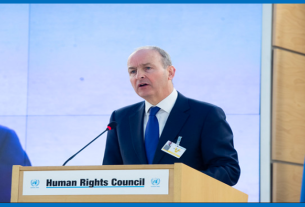In a statement issued following Sunday’s mission led by the UN’s Resident Coordinator in Azerbaijan, together with other senior agency officials, they heard and saw for themselves that in the city of Khankendi at least, there were no signs of damage to public buildings.
“The mission was struck by the sudden manner in which the local population left their homes and the suffering the experience must have caused,” the UN team said.
The team added that they did not hear – from either locals interviewed or others – of incidences of violence against civilians following the latest ceasefire.
“The team heard from interlocutors that between 50 and 1,000 ethnic Armenians remain in the Karabakh region.”
Saw no damage
During their visit, the UN team travelled from Aghdam to Khankendi, which is also known by ethnic Armenians as Stepanakert.
In the areas they visited, there was no visible damage to public infrastructure, including hospitals, schools, housing, or cultural and religious structures. Additionally, shops were closed.
The team noted that the Government of Azerbaijan was making preparations to restore health services and certain utilities in the city.
The mission did not get access to rural areas, but did not see any signs of destruction of agricultural infrastructure or livestock.
Lachin route
The mission followed the Lachin road to the border crossing, a route taken by over 100,000 ethnic Armenians in recent days. They did not encounter civilian vehicles heading towards Armenia.
The team said that “it is difficult to determine at this stage whether the local population intends to return”, from the conversations they were able to have.
What was clear is that there is a need to build trust and confidence, and this will require time and effort from all sides, the statement added.
It also called for all efforts to be made to ensure the protection of the rights of the local population, adding that the UN team in Azerbaijan stands ready to support the remaining local population and those who wish to return, in support of the Government of Azerbaijan.
Refugees at a registration centre in Goris, Armenia, on 29 September.
Situation in Armenia
In Armenia, the majority of refugees who arrived in the border town of Goris have since dispersed to other parts of the country.
The International Organization for Migration (IOM) has reported that many of those who sought refuge in Armenia undertook arduous journeys, often walking for days and finding shelter in caves or basements, enduring extremely challenging conditions.
“There are reports of malnutrition, particularly among the elderly and among children, and diseases such as high fevers and pneumonia,” Joe Lowry, IOM spokesperson told UN News in an interview on Monday from Yerevan, Armenia.
Mental health prioritized
Collaborating closely with the Government of Armenia, UN teams in the country are making mental health support a top priority for the refugees. On Monday, IOM opened two mobile clinics, with four more to be opened in the coming days.
The clinics will have trained psychologist on hand to help people with their immediate mental health and psychosocial needs, and to refer them onward for care, as needed, he told UN News.
Other UN agencies also continue their response. On Monday, the UN Children’s Fund (UNICEF) delivered vital medical supplies, including bandages, syringes and medications.
The UN Population Fund (UNFPA), for its part, is delivering hygiene kits to refugee women and girls in several regions in Armenia. It also trained local partners on responding to gender-based violence, and plans to set up safe spaces where survivors can access medical and mental health services.
New services
Given the influx of approximately 100,000 into a country with a population of around three million, there will be a significant demand for the expansion of national services. This includes bolstering educational institutions and healthcare facilities.
“People will need new schools, which will have to be built – it won’t be a case of adding four or five more chairs into a classroom – new schools or wings on schools will have to be built, the same for hospitals, too,” Mr. Lowry said.
He emphasized that the arrivals would also need livelihood assistance, such as jobs, and new homes. At the same time, the host community will also require support.



